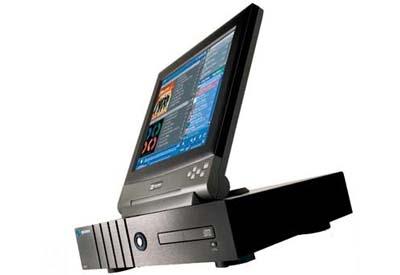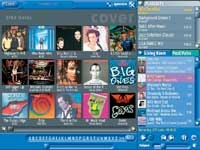Qsonix Q100 Music Server

| What We Think |
| This multiroom music server offers excellent sound and an interface as gorgeous as it is easy to use. |
That appears to be the driving force behind the Qsonix Q100 music server. With a 160-gigabyte (GB) hard drive and two independent audio outputs, the Q100 stores, manages, and serves up your music library to a pair of rooms in two separate but equally sweet helpings. Of course, media servers with giga-size hard drives that store thousands of songs aren't new. But finding a particular song can mean navigating through line upon line of text, and creating playlists to simplify things can be tedious.
The real treat in the Qsonix Q100 is its 15-inch touchpanel controller. It has a drag-and-drop interface for song selection that's powerful and effortless to use. Its operation will be totally familiar to anyone who's used a Windows or Macintosh computer, yet the application feels completely new and different.
People love their iPods because, while shuttling through their collections, they develop an emotional, tactile connection to their music through the Click Wheel. Multiply that effect by a factor of 10, and you'll have an idea of what the Qsonix interface is like.
SETUP Right out of the box, the system looked and felt well built. From the milled faceplate to the quality of the gold-plated audio outputs, it was clear that the Q100 was meant for classy digs.
Installation couldn't have been easier. In fact, if every component installed as easily as the Qsonix system, a lot of installers would be out of work. I simply connected the Zone 1 stereo analog output to my main listening rig and the matching Zone 2 output to my house-wide music system. A coaxial digital output is also available for Zone 1, but using it on my sample defeated the Zone 2 output. Qsonix's Version 2 software upgrade, which should be available by the time you read this, corrects this deficiency and some others I'll point out.
I connected my network router to the Qsonix's Ethernet port to give it Internet access for finding album and track information. Two connections marry the server to the touchpanel - a VGA and an RS-232 serial cable. Power the two pieces up, and you're done.
 Firing up the touchpanel produced a First Time Startup Wizard on its screen. It asked me to establish a network connection, which was as easy as pressing "Auto Configure" - happily, the Q100 adheres to the DHCP (Dynamic Host Configuration Protocol) networking standard, which automatically assigns IP addresses. Then the Wizard walked me through setting the date and time, the default recording quality, and names for the audio zones. The entire set-up process, including unboxing everything, took less than 15 minutes.
Firing up the touchpanel produced a First Time Startup Wizard on its screen. It asked me to establish a network connection, which was as easy as pressing "Auto Configure" - happily, the Q100 adheres to the DHCP (Dynamic Host Configuration Protocol) networking standard, which automatically assigns IP addresses. Then the Wizard walked me through setting the date and time, the default recording quality, and names for the audio zones. The entire set-up process, including unboxing everything, took less than 15 minutes.
There are some additional connections worth mentioning. A second RS-232 jack can send data and control commands to advanced touchscreen controllers by the likes of Crestron or AMX, which will be important to anyone looking to integrate Qsonix with a full-blown multiroom audio system. Two USB jacks are also provided for "Future Upgrades," such as the ability to add external hard drives to back up your ripped media.
The 6-foot cabling that connects the touchpanel to the server is way too short to be of any practical benefit; I was forced to sit on the floor while operating the touchpanel. Unless you plan on setting the touchpanel very near the server, insist on longer cables. An optional Cat-5 extension kit ($499) allows the touchpanel to be installed up to 600 feet away.
- Log in or register to post comments


































































